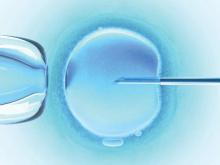HELSINKI – The risk of preterm birth and low birth weight is higher following oocyte donation for in vitro fertilization, compared with autologous IVF, according to a review of more than 100,000 singleton live births.
The findings could help in counseling women and when managing pregnancies resulting from oocyte donation IVF, Mohan S. Kamath, MBBS, reported at the annual meeting of the European Society of Human Reproduction and Embryology.
In a review of 100,092 singleton live births among women who underwent either fresh donor oocyte or autologous IVF, the rates of several outcomes were increased among the donor recipients. For example, preterm birth, defined as live birth before 37 weeks’ gestation, occurred in 14.8% vs. 9.4% of patients in the groups, respectively (odds ratio, 1.68), early preterm birth (live birth before 32 weeks’ gestation) occurred in 2.1% and 1.8% of patients (OR, 1.77), low birth weight (less than 2,500 g), occurred in 13.8% vs. 9.5% of patients (OR, 1.53), and very low birth weight (less than 1,500 g) occurred in 2.65% vs. 1.9% of patients (OR, 1.42).
The differences between the groups were statistically significant, said Dr. Kamath of Christian Medical College and Hospital, Vellore, India.
After adjusting for potential confounders, including female age, treatment duration, previous live birth, number of embryos transferred, single vs. multiple pregnancies resulting in singleton birth, and day of embryo transfer (before 5 days vs. 5 days or later), the increase in the risk of adverse perinatal outcomes of preterm birth, early preterm birth, and low birth weight remained significant (adjusted OR, 1.56, 1.41, and 1.43, respectively), he said.
The findings are important because the burden of poor ovarian response following IVF has been increasing, likely as a result of delayed childbearing and thus advanced age among those seeking IVF, Dr. Kamath said. However, little information is available regarding maternal or infant outcomes following oocyte donation, and the data that do exist have been conflicting, he said.
The increased risk of pregnancy complications following assisted reproductive technology, compared with spontaneously conceived pregnancies, has been largely attributed to the underlying infertility itself or to embryo-specific epigenetic modifications because of the in vitro fertilization techniques. The current study was conducted to determine whether use of donor oocytes affects obstetric and perinatal outcomes when compared with pregnancies that follow autologous IVF.
Anonymous data were obtained from the Human Fertilisation & Embryology Authority of the United Kingdom, which has collected data on all assisted reproductive treatment in the United Kingdom since 1991. For the current analysis, data from 1991 to 2011, including all singleton live births following fresh oocyte donor and autologous IVF cycles, were evaluated.
Although the dataset did not include information on potential confounders, such as smoking, body mass index, and medical history during pregnancy, the findings provide important insight into potential outcomes, Dr. Kamath said.
Dr. Kamath reported having no financial disclosures.


